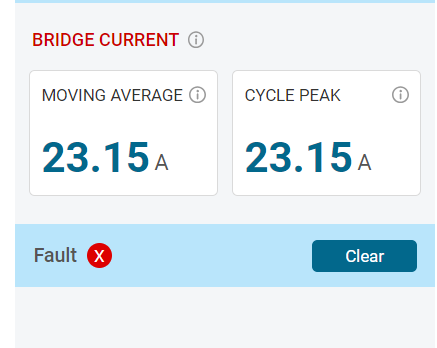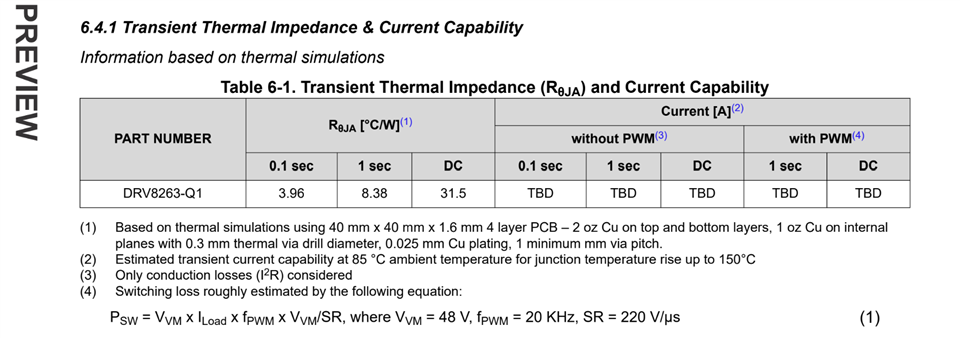Tool/software:
Hi Expert,
As the title, how to set the overcurrent value to 29A?
The output current is about 23A.

Thanks a lot!
Andy
This thread has been locked.
If you have a related question, please click the "Ask a related question" button in the top right corner. The newly created question will be automatically linked to this question.
Tool/software:
Hi Expert,
As the title, how to set the overcurrent value to 29A?
The output current is about 23A.

Thanks a lot!
Andy
Hi Andy,
Thank you for your question.
For the DRV8263H-Q1 device, the hardware control variant the IOCP threshold is a hard-coded fixed value of 29 A MIN. This cannot be changed. It can be changed only in the SPI variant, the DRV8263S-Q1.

You must be encountering a thermal shutdown. See the current capability table - TBD values are populated in the 2nd table.


Regards, Murugavel
Hi Murugavel,
Do you have any suggestion to improve the output current?
Andy
Hi Andy,
The table provides the current capability of the device with our EVM PCB and with 48 V supply voltage. Exceeding these currents will result in TSD. What is the expected peak current and duration and expected continuous current, corresponding VM voltage for your application? The device can provide higher currents for example > 12. 7 A for shorter durations < 0.1 s while driven without PWM. Thank you.
Regards, Murugavel
Hi Murugavel,
The customer's application scenario involves using a driver chip to control a small motor through PWM in a 24V automotive system. Considering EMC, a 6.8uF capacitor is connected in parallel to the two poles of the motor's brush. Due to the presence of this capacitor, the load during driving is capacitive, resulting in a significant inrush current at power-on, reaching approximately 20A and lasting for about 1ms. Therefore, when choosing the motor driver chip, the customer selected our chip, which has an IOCP of around 29A in the specification. The customer believed it should be able to drive the motor, but in actual application, it failed to do so. The development board's software indicated an error, with the current at 23.15A. The customer is puzzled as to why the current is not 29A. Regarding this issue, is it possible to improve it by adjusting other control parameters of the motor, such as the PWM frequency?
BTW, For CSPR 25, 2016 conducted emissions (voltage method and current method), due to the presence of sparks in the commutation of the brush motor, it will exceed the limit value required by EMC, what good advice can be given?
Thanks a lot!
Andy
Hi Andy,
Due to the presence of this capacitor, the load during driving is capacitive, resulting in a significant inrush current at power-on, reaching approximately 20A and lasting for about 1ms. Therefore, when choosing the motor driver chip, the customer selected our chip, which has an IOCP of around 29A in the specification. The customer believed it should be able to drive the motor, but in actual application, it failed to do so. The development board's software indicated an error, with the current at 23.15A. The customer is puzzled as to why the current is not 29A.
Most likely the device was experiencing a TSD condition before an OCP can happen. We will know this for sure only if the customer captures the current waveform triggered with the nFAULT falling edge. The EVM current sampling is not super fast which means it likely did not capture the actual current peak. So a display of 23.15 A in the EVM does not mean it was the actual peak current. Only a current waveform capture will reveal the actual peak value. Can we get this waveform for analysis?
Considering EMC, a 6.8uF capacitor is connected in parallel to the two poles of the motor's brush.
BTW, For CSPR 25, 2016 conducted emissions (voltage method and current method), due to the presence of sparks in the commutation of the brush motor, it will exceed the limit value required by EMC, what good advice can be given?
6.8 uF is a very large value of capacitance across the motor. Many customers are using our BDC drivers do drive BDC motors and pass CSPR 25. Usually a capacitor in the range of 100 nF is connected across the motor terminals at the motor itself.
Regards, Murugavel